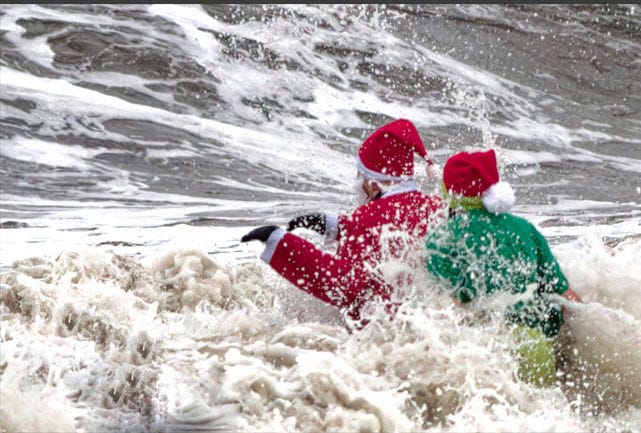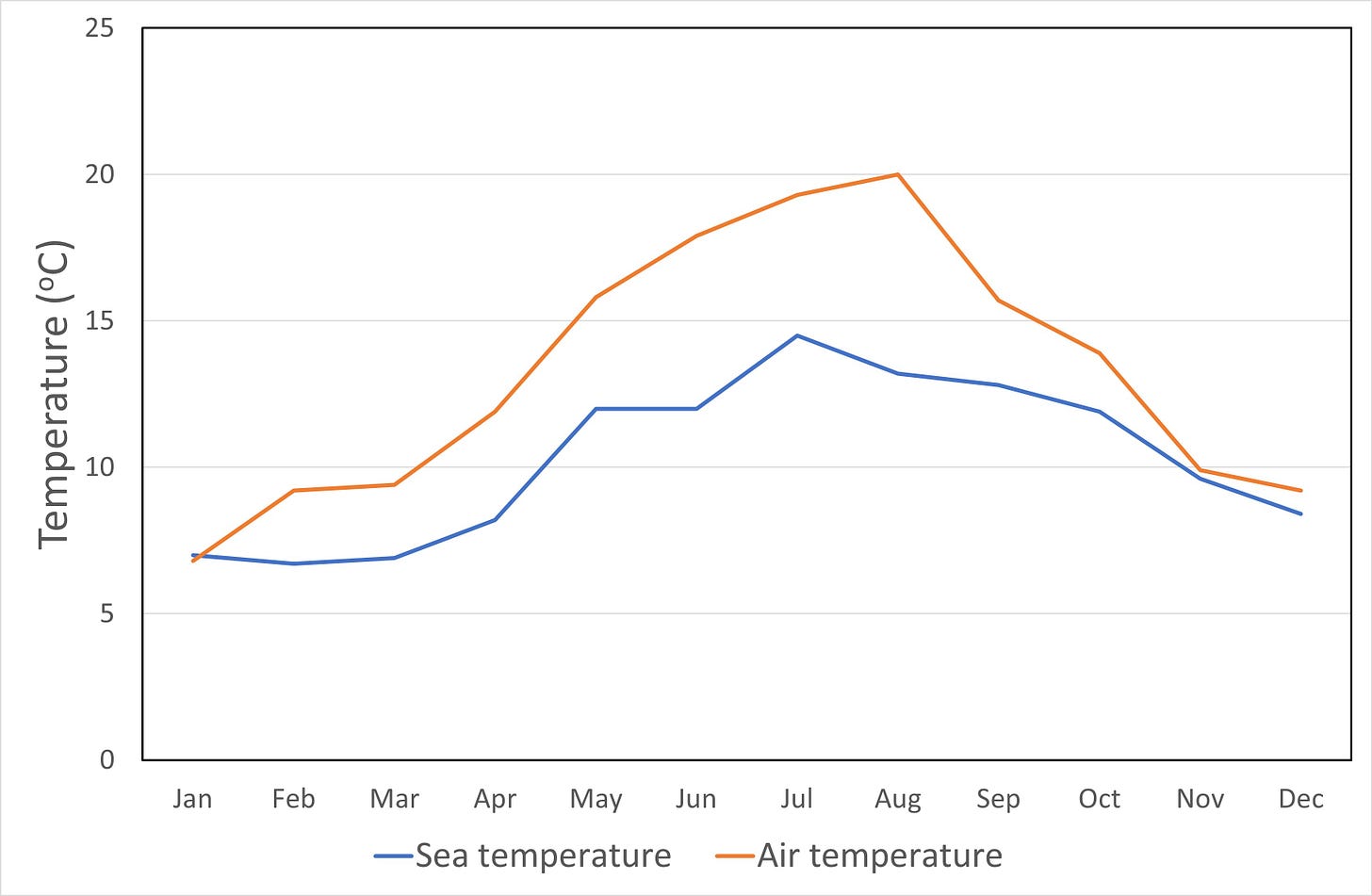Last summer, I made the bold statement that I would swim in the sea every month until the end of the year. A fine thing to say if you live in the Caribbean but a bit more ambitious for me at least in Scottish waters.
This was with a view to taking part in the New Year's Day celebrations, where the tradition of taking a dip is known as the Loony Dook. On my only previous attempt, I'd approached it without any preparation and had the early stages of what I now know was cold water shock, although happily soon recovered once out of the water.
A santa and elf brave the waves on 1 January 2025
My first swim of 2024 was in May during what the Met Office has recently identified as a marine heat wave. My own dip went fine, feeling cold and with some trepidation, but at least making a start.
Marine heatwaves are defined as periods of at least 5-days exceeding the 90th percentile of sea surface temperature (SST), calculated from the first 30-years of the satellite observation period (1982-2012). They are then categorised on a scale of I (moderate) to IV (extreme) based on deviation from local climatology. For the waters around the UK in May, the marine heatwave threshold is 11.3°C. The SSTs around the UK were nearly 1°C above this threshold in May 2024. From Met Office blog post ‘The unbelievable May that had everyone talking’.
Things got easier in the summer months although still with a slight sense of nervousness about just how cold it would be, but with 20+ degrees air temperatures and about 12-15oC in the water it was fine. However, I reached my limit on a chilly day towards the end of October when going in up to the waist was enough.
Not to be defeated, though, I returned the next day wearing a wetsuit I'd bought in a sale, which transformed the experience. In case you don't know, as opposed to a more expensive drysuit, with a wetsuit a thin layer of water still enters, but soon warms up keeping you comfortable, provided that you have the right thickness of neoprene for the conditions.
Experienced swimmers also suggest wearing neoprene boots, gloves and a hat as some people feel the cold more at their extremities so I got those as well. However, everyone is different and you don’t know until you experiment what’s most important (and for me I think that core body temperature is the main factor).
The November swim then saw a further drop in temperatures while due to other commitments I ended up missing a dip in December, which wasn’t a problem as January 1st was only a short time away.
The big day itself dawned with clear skies and a light onshore breeze but still choppy seas from a recent storm. Fortunately, wave heights of about three metres offshore were translating into a more manageable half metre or so at the beach.
Around lunchtime, a sizeable crowd had gathered with groups of swimmers occasionally running in, many in swimsuits but a few in fancy dress. As I waded in an hour or so later, following some initial hesitation a wave caught me by surprise and knocked me into the water, but with the wetsuit it felt fine, although I wasn’t tempted to stay in for long. A superb cup of hot chocolate in a local cafe soon warmed us up again.
So a fun experience despite my initial doubts earlier on. We measured an air temperature of 1oC just before the swim and someone who had been in an hour earlier had the foresight to take a waterproof thermometer, recording 6oC where we swam rather than the 8oC or so offshore shown in the graph below. This tied in with sea temperature forecasts for the day which showed that values would be about 2 degrees lower inshore than offshore. Interestingly, the forecasts also suggested that the coldest inshore waters in the UK that day would be further south in west Wales and around the East Anglia coast, rather than in Scotland.
Indicative water temperatures offshore and mean daily maximum air temperatures near where I swam (Jan-Dec 2024)
I’ve already been asked if I'll continue with this including on New Year's Day and think that I will, but at times of my choosing rather than to a monthly schedule.
Further reading
The Cefas WaveNet site showing near real time wave heights and sea temperatures from wave monitoring sites around the UK. The Centre for Environment, Fisheries and Aquaculture Science.
Met Office (2024) ‘The unbelievable May that had everyone talking’. Blog post 17 September 2024
Also, if you are interested in trying wild swimming yourself, my previous post on the topic ‘The reluctant wild swimmer’ has some links to expert advice on the risks you run and precautions you can take.







Interesting comparing your experience to mine. You are lucky to be near the sea, we're a couple of hours away in either direction so use rivers and lochs unless on a trip.
Some friends began swimming regularly about three years ago and were so enthused that I started joining them in the summer of 2023. The pool in the river was a balmy 19ºC then, but it still felt painfully cold and I still came out with hands and feet like blocks of ice. I subsequently bought wetsuit boots and gloves and my extremities are fine now. It took about six goes before I felt my body was adjusting.
We swim all year and I think that averaging about once a week keeps us attuned. Only one of our number wears a wetsuit, the rest of us wear swimming costumes all year. During the winter we often swim in sub zero air temperatures with ice on the fringes of the lochs (the river can be too wild and full of woody debris). In this mild January spell the water temperature has risen to about 4 or 5ºC. It's the wind that can really chill us, when we're changing on the bank afterwards.